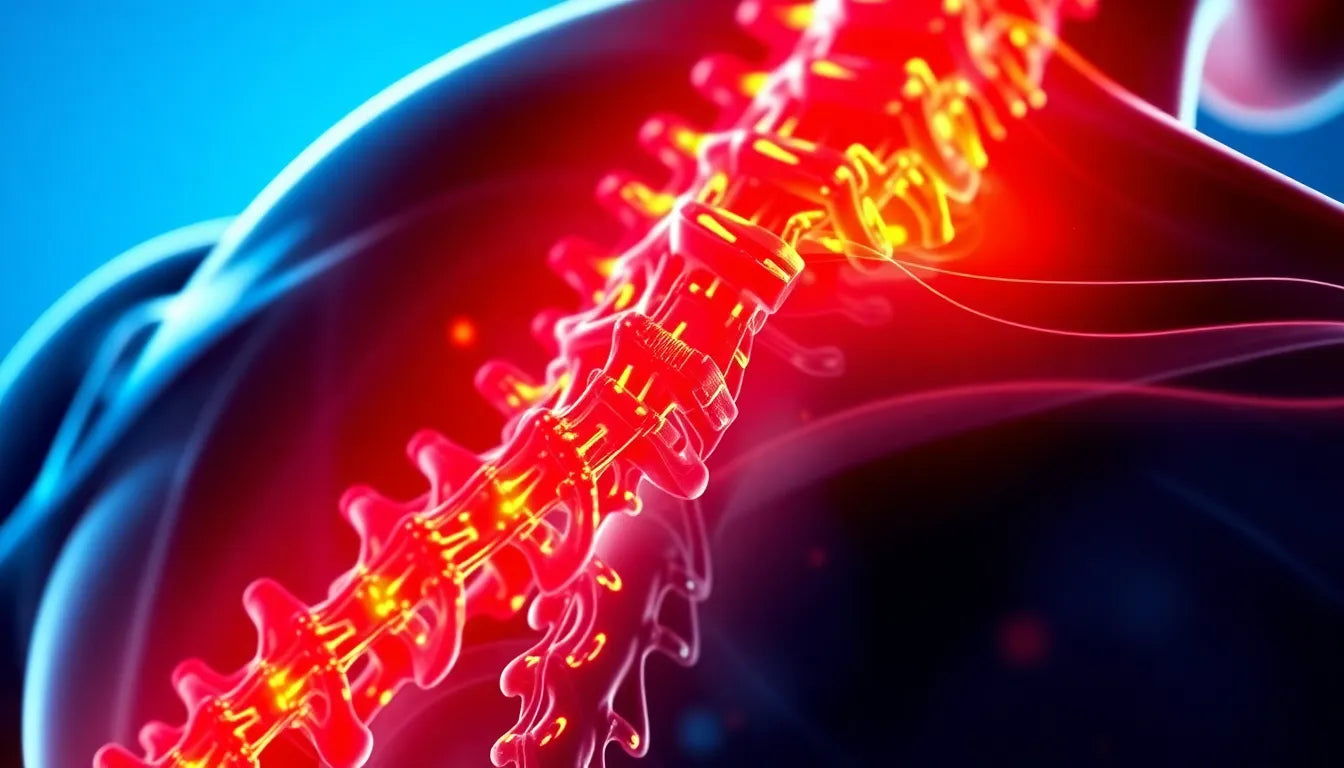The cervical spine is a marvel of engineering, providing both support and flexibility to our heads and necks. It consists of seven vertebrae, labeled C1 through C7, which form the uppermost section of the spine. Among these, the C5 and C6 vertebrae are particularly noteworthy due to their involvement in neck movement and support. However, this area is also prone to issues such as herniated discs, which can significantly impact daily life.
Understanding a C5/C6 herniated disc
A herniated disc occurs when the soft inner core of a spinal disc pushes through a crack in the tougher exterior casing. This can lead to nerve irritation and significant discomfort. Specifically, a herniated disc at the C5/C6 level affects the lower part of the neck, potentially causing pain and other symptoms that radiate into the shoulders, arms, and hands. This condition is not uncommon, particularly among individuals who engage in activities that place excessive strain on the neck, such as heavy lifting or prolonged periods of poor posture.
The prevalence of C5/C6 herniated discs is noteworthy, with many individuals experiencing symptoms that can hinder their ability to perform everyday tasks. The impact on quality of life can be profound, as pain and discomfort may limit mobility and reduce one's ability to engage in work or recreational activities. Understanding the nature of this condition is crucial for those affected, as it paves the way for effective management and relief.
The importance of expert insights
When dealing with a C5/C6 herniated disc, obtaining accurate information and guidance from experts is essential. Misunderstandings about the condition can lead to ineffective treatments or prolonged discomfort. Therefore, it is vital to rely on the insights of medical professionals who specialize in spinal health. They can provide a comprehensive overview of symptoms, treatment options, and long-term management strategies tailored to individual needs.
This blog post aims to shed light on the complexities of C5/C6 herniated discs by exploring the symptoms, available treatment options, and expert advice. By delving into these aspects, we hope to empower readers with the knowledge needed to make informed decisions about their health and well-being. Whether you're seeking relief from persistent pain or looking to prevent further complications, understanding the nuances of this condition is the first step towards recovery.
Symptoms of a C5/C6 herniated disc
Recognizing the symptoms of a C5/C6 herniated disc is crucial for early diagnosis and effective management. The most common symptom is pain, which typically manifests in the lower neck and shoulders. This discomfort can extend into the arms, often described as a sharp or burning sensation. Additionally, individuals may experience numbness, tingling, or weakness, particularly in the arms and wrist extensor muscles, which can significantly affect grip strength and dexterity.
Vision problems, though less common, can also occur due to nerve compression at this level. These symptoms can vary widely in intensity and may be intermittent or persistent. The table below summarizes the primary symptoms and the areas of the body they affect:
| Symptom | Affected Area |
|---|---|
| Pain | Lower neck, shoulders, arms |
| Numbness/Tingling | Arms, hands |
| Weakness | Wrist extensor muscles |
| Vision Problems | General vision |
Non-surgical treatment options for C5/C6 herniated disc
For many individuals, non-surgical treatments can effectively manage the symptoms of a C5/C6 herniated disc. One of the most common approaches is physical therapy, which focuses on exercises and techniques designed to improve mobility, strengthen neck muscles, and alleviate pain. A physical therapist can tailor a program to address specific needs, helping to reduce pressure on the affected nerve and enhance overall function.
Non-steroidal anti-inflammatory drugs (NSAIDs) are often prescribed to reduce inflammation and provide pain relief. These medications can be particularly beneficial when used in conjunction with physical therapy. Additionally, image-guided cervical epidural steroid injections may be recommended for more severe pain. These injections deliver corticosteroids directly to the affected area, reducing inflammation and alleviating pain.
It's important to note that the success of non-surgical treatments largely depends on a personalized approach. Working closely with healthcare providers to develop a tailored treatment plan can lead to better outcomes and a higher quality of life.
Surgical options for severe cases
When conservative treatments fail to provide sufficient relief, or if there is significant neurological impairment, surgical intervention may be considered. One of the most common surgical procedures for a C5/C6 herniated disc is Anterior Cervical Discectomy and Fusion (ACDF). This procedure involves removing the herniated disc and fusing the adjacent vertebrae to stabilize the spine.
Another option is anterior cervical foraminotomy, which aims to relieve pressure on the affected nerve by removing bone or soft tissue. For some patients, artificial disc replacement may be a viable alternative, allowing for the preservation of motion at the affected level.
Deciding on surgery involves careful consideration of various factors, including the severity of symptoms, overall health, and lifestyle. Exhausting non-surgical methods first is generally recommended to ensure all possible conservative measures have been explored.
Understanding the symptoms and exploring both non-surgical and surgical treatment options are vital steps in managing a C5/C6 herniated disc. By seeking expert advice and tailoring treatment plans to individual needs, patients can find relief and improve their quality of life.
Expert opinions and real-life experiences
When it comes to managing a C5/C6 herniated disc, expert insights can be invaluable. Dr. David Barnett, a renowned spinal specialist, emphasizes the importance of a conservative approach before considering surgical options. "Many patients find significant relief through non-surgical treatments, and surgery should be a last resort," he advises. This perspective aligns with the experiences of numerous patients who have successfully managed their symptoms through tailored physical therapy and medication.
Consider the case of Jane, a 45-year-old office worker who suffered from a C5/C6 herniated disc due to prolonged poor posture. After consulting with specialists and opting for a personalized non-surgical treatment plan, Jane experienced significant improvement in her symptoms. Her regimen included targeted exercises, NSAIDs, and lifestyle adjustments, which collectively enhanced her quality of life without the need for surgery.
Legal considerations and lifestyle adjustments
For individuals whose herniated disc is work-related, understanding the legal implications is crucial. According to the Aaron Allison Law Firm, workers' compensation claims can be pursued if the injury is linked to job activities. It’s advisable for affected individuals to consult with legal experts to explore their options and ensure they receive appropriate support and compensation.
Beyond legal considerations, making practical lifestyle adjustments can aid in recovery and prevention. Ergonomic aids, such as adjustable chairs and standing desks, can significantly reduce strain on the neck and promote better posture. Additionally, incorporating regular breaks and stretching exercises into daily routines can prevent further aggravation of the condition.
Conclusion
Understanding the symptoms and exploring both non-surgical and surgical treatment options are vital steps in managing a C5/C6 herniated disc. By seeking expert advice and tailoring treatment plans to individual needs, patients can find relief and improve their quality of life. Whether through conservative methods or, in more severe cases, surgical intervention, the path to recovery is best navigated with professional guidance and informed decision-making.
Frequently asked questions
What are the main symptoms of a C5/C6 herniated disc?
Pain in the neck, numbness, tingling in the arms, and muscle weakness are the primary symptoms associated with a C5/C6 herniated disc.
What are the non-surgical treatments available?
Non-surgical treatments include physical therapy, NSAID medications, and cervical epidural steroid injections, all of which can effectively manage symptoms.
When should surgery be considered for a C5/C6 herniated disc?
Surgery is considered when conservative treatments fail to relieve symptoms or if there is significant neurological impairment.
Can ergonomic aids help with recovery?
Yes, ergonomic aids can support posture and reduce strain, aiding in pain management and recovery, making them a valuable part of a comprehensive treatment plan.
Sources
- Barnett, D. (2023). "Cervical Herniated Disc: Symptoms and Treatment Options." Spine-Health.
- Deuk Spine Institute. (2023). "Herniated Disc Overview."
- Aaron Allison Law Firm. (2023). "Workers' Compensation for Herniated Disc Injuries."
- Alleviate Pain Clinic. (2023). "Conservative Approaches to Disc Bulges."


















